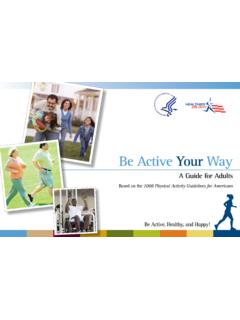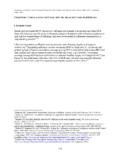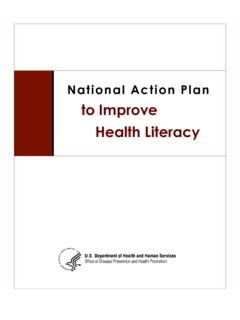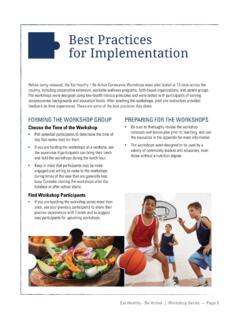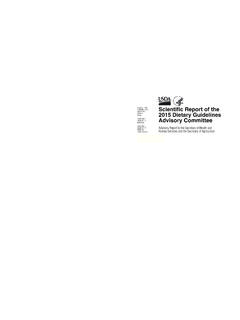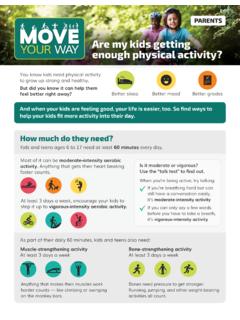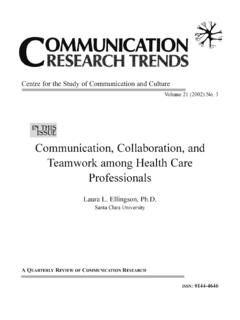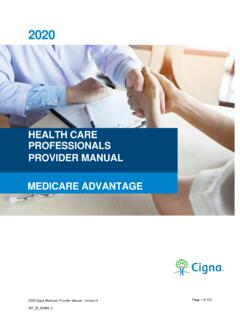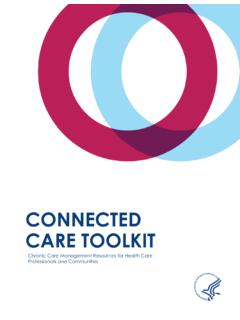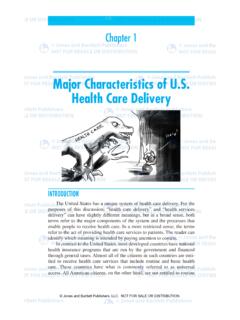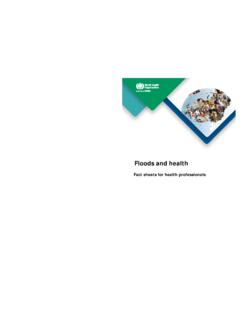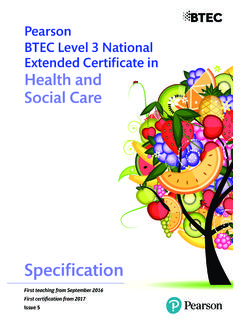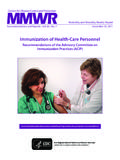Transcription of to Improve Health Literacy
1 Nation al Ac ti on Pl an to Improve Health Literacy Suggested citation: Department of Health and Human Services, Office of Disease Prevention and Health Promotion. (2010). National Action Plan to Improve Health Literacy . Washington, DC: Author. Foreword F. or more than 30 years, I've observed the difficulties many people face as they attempt to use our Health care system. I've seen firsthand the inequities in Health status and access to care and the outcomes that persist. My own experiences in treating patients, running a large government agency and overseeing academic research, have given me a unique perspective about the Nation's Health care and public Health systems, and more importantly the need to make Health Literacy a public Health priority.
2 Quite simply, the responsibility is ours as Health professionals to communicate in plain language. Without clear communication, we cannot expect people to adopt the healthy behaviors and recommendations that we champion. When people receive accurate, easy-to-use information about a Health issue, they are better able to take action to protect and promote their Health and wellness. That is why Health Literacy is so critical to our efforts in the Department of Health and Human Services. It is the currency for everything we do. Improving Health Literacy that is, the degree to which individuals have the capacity to obtain, process, and understand basic Health information and services needed to make appropriate Health decisions is critical to achieving the objectives set forth in Healthy People 2020 and, more broadly, key to the success of our national Health agenda.
3 We should address in a sustained manner the problem of Health Literacy in our Nation with a goal of improving Health status within and across populations. I remain personally and professionally passionate about working systematically to attain the highest standard of Health for the greatest possible number of people. Too often, there exists a chasm of knowledge between what professionals know and what consumers and patients understand. Basic Health Literacy is fundamental to the success of each interaction between Health care professionals and patients every prescription, every treatment, and every recovery. Basic Health Literacy is fundamental to putting sound public Health guidance into practice and helping people follow recommendations.
4 The National Action Plan to Improve Health Literacy envisions a restructuring of the ways we create and disseminate all types of Health information in this country. The plan also calls us to ensure that all children graduate with Health Literacy skills that will help them live healthier throughout their lifespan. National Action Plan to Improve Health Literacy | iii Foreword So many large and small steps are at our disposal. The time to act is at hand. This volume sets forth thoughtful, achievable objectives and describes what is required to create and sustain a Health literate Nation. Accordingly, I wholeheartedly endorse this thoughtful document and the blueprint it offers. Working cooperatively, let us realize the vision it offers in the lives of people everywhere.
5 Sincerely, Howard K. Koh, , Assistant Secretary for Health National Action Plan to Improve Health Literacy | iv Contents Foreword ..iii Contents ..v Summary ..1. Introduction ..3. Understanding and Defining Health Literacy .. 4. Section 1: Limited Health Literacy as a Public Health Problem .. 7. Prevalence of Limited Health Literacy (Epidemiology) .. 7. Health Literacy and Outcomes .. 9. Innovative Approaches To Improve Health Literacy .. 10. Section 2: Developing a Societywide Health Response .. 13. Section 3: Vision and Goals for the Future .. 16. Goal 1 Develop and Disseminate Health and Safety Information That Is Accurate, Accessible, and Actionable .. 18. Goal 2 Promote Changes in the Health care Delivery System That Improve Health Information, Communication, Informed Decisionmaking, and Access to Health Services.
6 25. Goal 3 Incorporate Accurate, Standards-Based, and Developmentally Appropriate Health and Science Information and Curricula in Child care and Education Through the University Level .. 32. Goal 4 Support and Expand Local Efforts To Provide Adult Education, English Language Instruction, and Culturally and Linguistically Appropriate Health Information Services in the Community .. 35. Goal 5 Build Partnerships, Develop Guidance, and Change Policies .. 39. Goal 6 Increase Basic Research and the Development, Implementation, and Evaluation of Practices and Interventions To Improve Health Literacy .. 43. Goal 7 Increase the Dissemination and Use of Evidence-Based Health Literacy Practices and Interventions .. 45. Section 4: Creating and Sustaining National Action.
7 48. Appendix A: References .. 50. Appendix B: What You Can Do To Improve Health 59. Appendix C: Acknowledgments .. 63. National Action Plan to Improve Health Literacy | v Summary T. his National Action Plan to Improve Health Literacy seeks to engage organizations, professionals, policymakers, communities, individuals, and families in a linked, multisector effort to Improve Health Literacy . The plan is based on the principles that (1) everyone has the right to Health information that helps them make informed decisions and (2) Health services should be delivered in ways that are understandable and beneficial to Health , longevity, and quality of life. The vision informing this plan is of a society that: Provides everyone with access to accurate and actionable Health information Delivers person-centered Health information and services Supports lifelong learning and skills to promote good Health Two decades of research indicate that today's Health information is presented in a way that isn't usable by most Americans.
8 Nearly 9 out of 10 adults have difficulty using the everyday Health information that is routinely available in our Health care facilities, retail outlets, media, and , 2, 3 (References are presented in Appendix A.) Without clear information and an understanding of prevention and self- management of conditions, people are more likely to skip necessary medical tests. They also end up in the emergency room more often, and they have a hard time managing chronic diseases, such as diabetes or high blood Health Literacy is the degree to which individuals have the capacity to obtain, process, and understand basic Health information and services needed to make appropriate Health Limited Health Literacy affects people of all ages, races, incomes, and education levels, but the impact of limited Health Literacy disproportionately affects lower socioeconomic and minority groups.
9 It affects people's ability to search for and use Health information, adopt healthy behaviors, and act on important public Health alerts. Limited Health Literacy is also associated with worse Health outcomes and higher This report contains seven goals that will Improve Health Literacy and suggests strategies for achieving them: 1. Develop and disseminate Health and safety information that is accurate, accessible, and actionable 2. Promote changes in the Health care system that Improve Health information, communication, informed decisionmaking, and access to Health services National Action Plan to Improve Health Literacy | 1. Summary 3. Incorporate accurate, standards-based, and developmentally appropriate Health and science information and curricula in child care and education through the university level 4.
10 Support and expand local efforts to provide adult education, English language instruction, and culturally and linguistically appropriate Health information services in the community 5. Build partnerships, develop guidance, and change policies 6. Increase basic research and the development, implementation, and evaluation of practices and interventions to Improve Health Literacy 7. Increase the dissemination and use of evidence-based Health Literacy practices and interventions Many of the strategies highlight actions that particular organizations or professions can take to further these goals. It will take everyone working together in a linked and coordinated manner to Improve access to accurate and actionable Health information and usable Health services.
